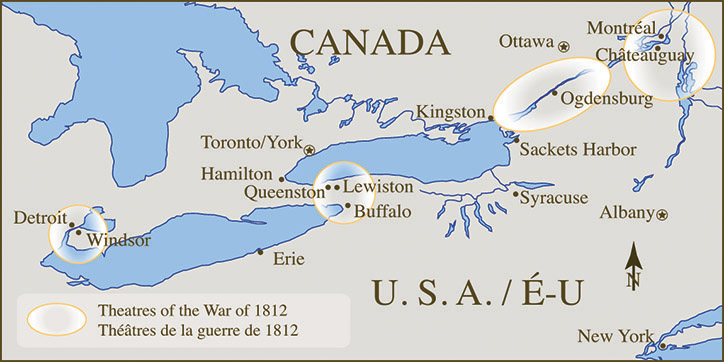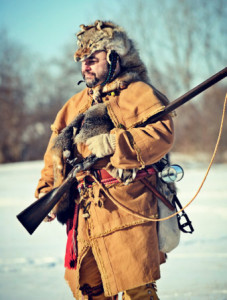2012 was the 200th anniversary of the War of 1812, and the commemorations brought a revival of interest in this historical event. The War was the occasion for Francis Scott Key’s writing of the Star Spangled Banner, and for Dolly Madison’s rescue of an important portrait of George Washington as she fled the White House hours before the invading British Army sacked it. The Battle of New Orleans, which inspired a famous country-western song, was also a part of this war. Other than these events, however, most people don’t know why or where it was fought or even whom we were fighting against. It is often called the “forgotten war.”
The War of 1812, between the United States and Great Britain, was fought to resolve issues left unsettled by the Revolutionary War, which took place 35 years earlier. Some issues were specific, such as whether British ships could “impress” (take as forced labor) captured American seamen. A major, more general issue was how the lands to the west of the original colonies were going to be settled and who was in charge of this process. The British wanted to claim ownership of some western lands, particularly those adjoining Canada. Native Americans also wanted ownership of some of these lands. Tecumseh, a Native American leader, and his tribal confederation, sided with British in the War because the British promised them a homeland west of the settled areas of the United States. The British, the Canadians, and many Indians wanted to curb what they saw as aggressive American expansionism westward.
The Great Lakes region, on the border between Canada and the U.S. and newly opened for settlement by the American government, was a major theater of the War. Our ancestors of the Waldo, Love, Duval, and Nadeau families had migrated to territories along the Great Lakes after the Revolutionary War as these areas became available for homesteading. These ancestors were involved in the War as combatants or as civilians in a war zone. The map below shows the major battles of the great lakes region, including those in which our ancestors were engaged. Ephraim Waldo at the Battle of Queenston Heights, Canada (on the Niagara River between Lake Erie and Lake Ontario); Robert and Levi Love at the Battle at Sacket’s Harbor, New York (on the eastern edge of Lake Ontario); and our Duval and Nadeau ancestors at the Battles of the Raisin River, Frenchtown, Michigan Territory (south of Detroit).
EPHRAIM WALDO AT THE BATTLE OF QUEENSTON HEIGHTS, ONTARIO, CANADA, OCTOBER, 1812
Ephraim Waldo, born in 1764 on a farm in Connecticut, came from a long line of New Englanders. His father, Jesse Waldo, had been a Lieutenant in the Revolutionary War. Ephraim married Eunice Dimmock and in 1789 they became pioneer settlers in the wilderness of western New York, settling in Bridgewater, Oneida County, where they started a store and raised a family. Ephraim also worked as a blacksmith. When war was declared in 1812, the family had moved to Niagara County, New York. Ephraim, then 48 years old, enlisted in the military, and travelled about forty miles west from his home to join the War at the Canadian American border on the Niagara River.
The Americans planned to invade Canada early in the War at various points, expecting an easy victory over the unprepared British. One invasion took place on the Niagara River, where the American army and local militia assembled in Lewiston, on the American side (shown at left in picture), and crossed the River to attack Queenston Heights, Canada (shown at right in picture). Unfortunately for the Americans, they had difficulty in getting their soldiers across the river, giving British reinforcements time to arrive and aid in the defense of Queenston Heights. The British repelled the invasion, which ended in a chaotic American retreat back across the river.
Ephraim Waldo died in this battle. Waldo family historian Lincoln Waldo, in interviews with Ephraim’s descendants about ninety years later, recorded family memories of Ephraim’s death:
“He [Ephraim Waldo] . . . was present and took part in the Battle of Queenston Heights, Oct. 13, 1812, and was never heard of afterwards. It is a tradition in the family that, while the American army was retreating or being driven towards the river, Ephraim was seen by a cousin or an uncle, who was in the ranks with him, to fall – whether from a stumble or a wound is unknown – and his comrade, looking back, saw him leaning on his sword as if wounded, and the Indians coming up behind him. His fate is unknown. After the surrender of the Americans, he was looked for among the dead, wounded and prisoners, but was not found, hence it is supposed that he succeeded in reaching the Heights, attempted to swim the river and was drowned in the attempt, like many others. He was a good swimmer, and, if not wounded, perhaps would have escaped. It is related of him, that, having been captured by a press gang and placed on board a man-of-war, off Quebec, he jumped overboard in the night and swam ashore, a distance of three miles. (Lincoln Waldo, Genealogy of the Waldo Family from 1647 to 1900, Worcester, Mass.: Press of Charles Hamilton, 1900, pp. 326-328).
At the time of his death, he left four children by his first wife, Eunice (Dimmock), including our ancestor, Eunice Waldo, and several children by his second wife.
How you are related to Ephraim Waldo
On your personal Ancestor Fan Chart, trace your lineage from your name, in the center of the fan, to Eunice Waldo, on the outermost rim. Then, open the attached Eunice Waldo Ancestor Fan Chart. Her name is at the center, and her father is Ephraim.
ROBERT AND LEVI LOVE AND THE BATTLE AT SACKET’S HARBOR
Robert Love, the grandson of Scotch-Irish immigrants, Adam and Mary Love, was born in 1767 in Rhode Island. In later years he recounted that while working on the farm as a boy, he saw a cavalcade of Revolutionary War officers pass by on their way westward. Their leader was George Washington. His father, Sergeant Robert Love, served more than three years in the Revolutionary army, and was perhaps in service at the time that young Robert saw the officers. (William DeLoss Love, Love Family History, unpublished ms. New Haven, CT, 1918, pp. 36-39).
As a young man Robert moved first to Connecticut and there married Susanna Austin. Together they took the pioneer journey to the western wilderness of New York State, where they made a clearing in the forest in Oneida County, and with a few other families, established the settlement of Bridgewater. Among their neighbors were Ephraim and Eunice Waldo, whose involvement in the War of 1812 is discussed above. Ephraim and Eunice’s daughter, Eunice, grew up to marry her childhood friend in Bridgewater, Levi Love, son of Robert and Susanna Love. In this way the Loves and Waldos became in-laws and the ancestors of all of us who descend from Levi and Eunice Love.
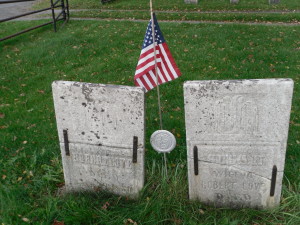
Robert and Susan Love tombstones, with medallion for service in War of 1812. Fairview Cemetery, Bridgewater, NY. Photo by Judylove1157 at ancestry.com
At the time of the War, Robert was 45 and had several grown children.. Robert and three of his sons, including our ancestor Levi, enlisted in the militia. They were called upon to do guard duty at Sacket’s Harbor, about 100 miles north of their home. Sacket’s Harbor, located on the eastern edge of Lake Ontario, was a major U.S. Naval base. In July, 1812, a fleet of British ships sailed toward the base, intending to capture it. The American military successfully deployed cannon and artillery, located on shore, to disable the British ships. The British fleet retreated, and the Americans claimed victory. The militia, including our ancestors, mainly stood guard and did not have a role in the fight, since the British did not land.
Eighty years later, Levi’s son, Lorenzo, wrote his memories of what his father told him about this episode.
“During the War of 1812 between England and the United States, grandfather [Robert] with my father [Levi], George and William, father’s brothers, were called out to defend Sacket’s Harbor on the water. The fleet was called the Royal George. The British on the water and the Americans on the land fought with cannon all day Sunday and at evening [the British] sailed away. That ended the war in that quarter and father and all came home.” (Lorenzo Love, letter to Charley love, Berrien Springs, Michigan, Feb. 10, 1895. The letter was reproduced in Love Family Quarterly, St. Petersburg, FL, Vol. IIl, Oct. 1955, pp. 5-6).)
Charley Love, Levi’s grandson, had these recollections.
“The last time I saw my grandfather Love to talk with him he said he had the papers to fill out for a pension in the War of 1812 but because he was only out a few days at Sacket’s Harbor, he did not feel that he ought to apply for a pension. Said he would liked to have done more for his country than he did, but his family was young and he was poor and he was needed at home and his colonel gave him leave of absence as soon as he felt he could spare him.” (Charley Love, Note to letter from Lorenzo Love, 1895. Reproduced in Love Family Quarterly, published in St. Petersburg, FL, Vol. IIl, Oct. 1955, pp. 5-6)
How you are related to Robert and Levi Love
On your personal Ancestor Fan Chart, follow your lineage out to Levi Love, on the outermost rim. Then open the attached Levi Love Ancestor Fan Chart. His name is in the center, and his father is Robert Love.
OUR FRENCH CANADIAN ANCESTORS AND THE RAISIN RIVER BATTLES OF THE WAR OF 1812
The recent creation of the Raisin River National Battlefield Park in Monroe, Michigan, has highlighted the strategic role played by that community in the War of 1812. Known as Frenchtown because of the large number of French Canadians who immigrated from Canada and settled along the banks of the Raisin River after the American Revolution, at the time of the War it had grown to become the second largest settlement in Michigan Territory.
For the French living in the Raisin River area, the War initially created a conflict of loyalties. They wanted to get along with the new American government and to be cooperative citizens of Michigan Territory. Yet they also had ties to the opposing side. Many owed possession of their farms to the negotiations they had made with local Native American leaders. Native Americans, who feared the loss of their land to the encroaching American settlers, chose to ally themselves with the British-Canadian side in the War.
Immigrants from Canada themselves, the French also had family and business ties to that 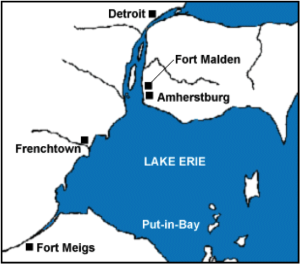 country. At the time of the War, Frenchtown was surrounded to the North, East, and West by British-Canadian military and their Native American allies. The American military was far to the south at Fort Meigs, Ohio, separated from Frenchtown by an almost impassable geographical barrier, the Great Black Swamp.
country. At the time of the War, Frenchtown was surrounded to the North, East, and West by British-Canadian military and their Native American allies. The American military was far to the south at Fort Meigs, Ohio, separated from Frenchtown by an almost impassable geographical barrier, the Great Black Swamp.
Our own French Canadian ancestors, the Duval and Nadeau families, had immigrated from Canada to the Detroit region in the 1780s, and owned farms in the Frenchtown area. Records are scarce concerning the specific actions of local civilians during the War, but it is reasonable to assume that historical information on the French Canadian community includes the involvement of our specific ancestors.
From the beginning of the War in July, 1812 until the decisive American victories in late 1813, which effectively ended the War in the area, Frenchtown was the site of repeated invasions and occupations by the opposing armies. Its civilian inhabitants, both French and other American settlers, suffered as the battles were fought directly on their homes and farms.
The Habitants
The French Canadian settlers, known as habitants, aided the American side as scouts, suppliers and transporters of provisions, blacksmiths, and as members of the militia. During periods of British occupation, they had to find a way to co-exist with the occupiers. In one story, the habitants were charged with obtaining and escorting a large herd of cattle to provision the British army. As word came that an American army was working its way northward, the habitants sequestered the cattle in the woods. Later on, some of the cattle found their way to the American side, and the habitants may have purloined the rest.
In spite of their conflicts of loyalties, the habitants contributed greatly to the war effort. It is estimated that about 83 percent of the men eligible for service fought for the American side. One Kentucky soldier who fought in the decisive 1813 battle wrote: “”Our situation at present is an enviable one, compared to our past. Plenty of apples, cider, butter, etc. in abundance. The inhabitants [habitants] are numerous and very friendly. Several took arms and fought valiantly at our sides.”
Tecumseh
Tecumseh was a Native American leader who formed a confederation of tribes to try to negotiate 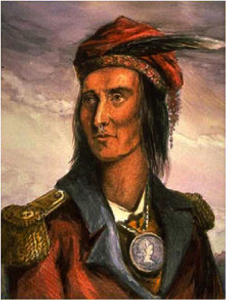 with the American government to establish a Native American homeland in Indiana and other Midwestern regions. When the War of 1812 broke out, he led his confederation into an alliance with the British, who promised his confederation a large homeland in the U.S. following victory in the War.
with the American government to establish a Native American homeland in Indiana and other Midwestern regions. When the War of 1812 broke out, he led his confederation into an alliance with the British, who promised his confederation a large homeland in the U.S. following victory in the War.
Tecumseh was a well-known figure in Frenchtown and was frequently in the area during the War. It is very likely that our ancestors there knew him personally, and, like other civilians there, had cause to be grateful to him. He had enlightened and humanitarian values, which he practiced even in the difficult circumstances of War. The rangers at the Raisin River National Battlefield Park tell visitors that on one occasion, he intervened when a band of Native Americans menaced the unprotected women and children in Frenchtown. In spite of the great injustices he and his people endured, he did not retaliate against innocent individuals. Today monuments and other commemorations in the U.S. and Canada acknowledge his vision for a peaceful co-existence between Native Americans and European settlers in America. A town near Frenchtown is named Tecumseh, in his memory, and the Civil War General, William Tecumseh Sherman, bore his name.
Remember the Raisin!
In January, 1813, in the farm settlement of Frenchtown, the British-Canadian forces and their 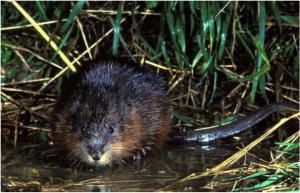 Native American allies won the Battle of Raisin River, which was the bloodiest fight of the entire War. The aftermath of this battle was horrendous. The victorious British abandoned a large number of wounded American soldiers who were their prisoners of war. The next day, a Native American raiding party arrived and massacred them all, an event now known as the Raisin River Massacre. In this time of terror, about half of the local population fled to other cities, where their fate depended on whether or not they had family or friends to harbor them. Those who remained experienced near starvation and survived on a diet of wild grapes from the banks of the Raisin River, boiled hay, and muskrat, a rodent found abundantly in the River. Today descendants of these early French Canadians still serve muskrat dishes at festivals, as part of their heritage.
Native American allies won the Battle of Raisin River, which was the bloodiest fight of the entire War. The aftermath of this battle was horrendous. The victorious British abandoned a large number of wounded American soldiers who were their prisoners of war. The next day, a Native American raiding party arrived and massacred them all, an event now known as the Raisin River Massacre. In this time of terror, about half of the local population fled to other cities, where their fate depended on whether or not they had family or friends to harbor them. Those who remained experienced near starvation and survived on a diet of wild grapes from the banks of the Raisin River, boiled hay, and muskrat, a rodent found abundantly in the River. Today descendants of these early French Canadians still serve muskrat dishes at festivals, as part of their heritage.
The massacre of American prisoners of war galvanized American public opinion to the cause. “Remember the Raisin” became a rallying cry for the war effort. Commodore Perry destroyed the British fleet on Lake Erie in September, 1813, and after that the tide of War turned in favor of the Americans. In the Battle of the Thames, at Ahmetsburg, Canada in October, 1813, (see map, above) the American army defeated the British and Native Americans and forced the retreat of British troops from Michigan territory, including Frenchtown. Tecumseh was killed in that battle, and with him, any realistic prospect of realizing the dream of aNative American homeland in the northern Midwest. After this decisive battle, the habitants and other residents of Frenchtown were able to begin the work of restoring their homes and farms. Within a few years the region was peaceful and prosperous once again.
How you are related to the Duvals and the Nadeaus
Go to your personal Ancestral Fan Chart and find the lineage that ends with Michael Thuot Duval and the lineage that ends with Agatha Nadeau. Then open the attached Ancestral Fan Charts for Michael Thuot Duval and here for Agatha Nadeau.
References for the Battle of Raisin River
Naveaux, Ralph. Monroe in the War of 1812. Available online at: http://1812monroe.com/about-2/history/
Essay in Wikipedia. U. S. Park Service River Raisin Battlefield National Park http://www.nps.gov/rira/index.htm

